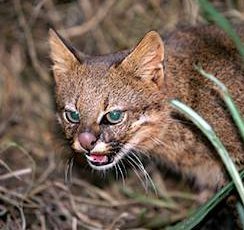Pampas cats

The Pampas cat is also known as the 'grass cat' because that's where this denizen of the South American grasslands prefers to live. It is small for a wild cat, being the size of a large domestic cat - i.e. a little over two feet long, with a weight of between 3 kg and 6 kg (6 to 13 pounds). Though relatively small, these are sturdy animals with muscular bodies that make their heads seem comptively small. They have thick bushy tails and tufted, pointed ears. The long coats vary in colour from yellowish-white to brown and silvery-grey. There is a large degree of variation between pampas cats depending on where they live. For example, the northern cats have rust-coloured rosettes and the western subspecies has black feet.
Pampas Cats are among the most common and most widely distributed of the wild cats of South America. They are found across western central South America, in an area from Ecuador and Chile across the Andes Mountains into Argentina and neighbouring countries. Despite this wide distribution, little is known about the Pampas cat. It is something of an ugly ducking in comparison to the Geoffroy's cat, and has no reason to feel jealous for this, as, unlike the Geoffroy's, it is not hunted for it's fur.
The Pampas cat is a truly wild animal, and can't be domesticated, so outside its native habitat there is only a handful of them in different zoos across the world. As the name says, their preferred environment is open grassland and humid forest, but they are equally comfortable in the mountainous Andes. Differences in colouring has allowed them to evolve the best camouflage for each region. Possibly they have learned that out of sight, out of mind is the best recipe for a long and undisturbed life, which is what most Pampas cats seem to live. The average lifespan appears to be of between 9 and 16 years. The major threat to these cats is the loss of habitat due to human settlement and domestic grazing.
Pampas cats eat small mammals, especially guinea-pigs, rodents and flightless birds. They are happy to add domestic poultry to the menu, especially in the coastal region of Chile where these cats make their homes relatively close to human farms.
What Cat? Whilst humans fall into two classes from the Pampas cat's point of view (Damn Nuisance, and Beneficent Poultry Provider), the official classification of Pampas cats as a species is an ever-changing nightmare to taxonomists. This is not only because there are clear physical differences between Pampas cats from different regions of South America, but also because there are very few cats available for genetic testing, apart from specimens in different museums and the few in captivity. Originally classed as a member of the Felislynchailurus genera, they were moved in 1993, when Wozencraft classified them as belonging to the genus Oncifelis because of their close relationship with the other members of this genus (Geoffroy's cat O. geoffroyi and the kodkod, O. guigna). In addition, the specific name pajeros has been used. Seven subspecies of the Pampas cat havr been described: O.c.braccatus, O.c.budini, O.c.colocolo, O.c.crespoi, O.c.garieppi, O.c.munoai, O.c.paajeros, O.c.thomasi.
However, since 2005, in accordance with the 'Mammal Species of the World. A Taxonomic and Geographic Reference (3rd ed)' edited by Don E. Wilson & DeeAnn M. Reeder and published by Johns Hopkins University Press, Pampas cat are currently classified as :
GENUS Leopardus - The genus consists of small spotted cats mostly native to Central and South America. The genus is considered the oldest branch of the cat family which crossed into the Americas in prehistoric times. The better-known members of the genus include: the Ocelot, Geoffroy's cat and Kodkod. Despite its name the genus does not include the Leopard which is found in the genus Panthera.
SPECIES Leopardus pajeros
Recent taxonomic changes have also resulted in the Pampas cat being split off from the Colocolo subspecies. In addition Leopardus braccatus is now considered a septe member of Leopardus genus (Pantanal Cat). So there are now only five subspecies: Leopardus pajeros pajeros, Leopardus pajeros budini, Leopardus pajeros garieppi, Leopardus pajeros steinbachi and Leopardus pajeros thomasi.

